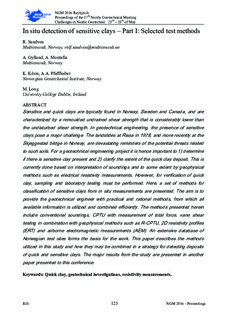| dc.description.abstract | Sensitive and quick clays are typically found in Norway, Sweden and Canada, and are characterized by a remoulded undrained shear strength that is considerably lower than the undisturbed shear strength. In geotechnical engineering, the presence of sensitive clays pose a major challenge. The landslides at Rissa in 1978, and more recently at the Skjeggestad bridge in Norway, are devastating reminders of the potential threats related to such soils. For a geotechnical engineering project it is hence important to 1) determine if there is sensitive clay present and 2) clarify the extent of the quick clay deposit. This is currently done based on interpretation of soundings and to some extent by geophysical methods such as electrical resistivity measurements. However, for verification of quick clay, sampling and laboratory testing must be performed. Here, a set of methods for classification of sensitive clays from in situ measurements are presented. The aim is to provide the geotechnical engineer with practical and rational methods, from which all available information is utilized and combined efficiently. The methods presented herein include conventional soundings, CPTU with measurement of total force, vane shear testing in combination with geophysical methods such as R-CPTU, 2D resistivity profiles (ERT) and airborne electromagnetic measurements (AEM). An extensive database of Norwegian test sites forms the basis for the work. This paper describes the methods utilized in this study and how they may be combined in a strategy for detecting deposits of quick and sensitive clays. The major results from the study are presented in another paper presented to this conference. | |
